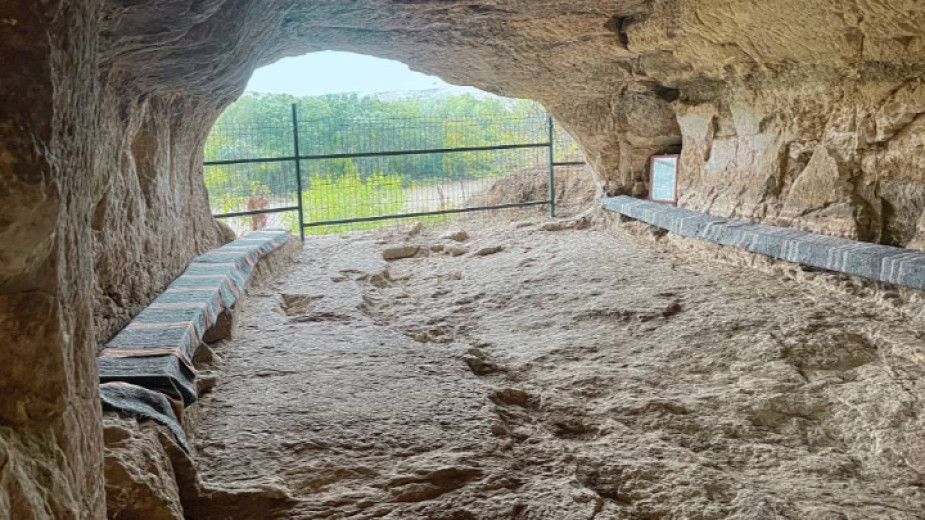 7
7
In Northeastern Bulgaria the river Rusenski Lom and its tributaries – Cherni, Beli and Malki Lom – have carved out a rugged rocky landscape with hidden caves and hushed valleys where the only sound is that of the birdsong. People have settled in these canyons through the ages, leaving their mysterious mark – dozens of rock monasteries, cells and churches, tucked away far from human eyes in the valley of the River Lom and its tributaries. Besides the famed Ivanovo rock churches and Basarbovo monastery, there are a number of other churches in the area which can only be reached by steep pathways. 
Elsewhere, for example in the monastery complex near Belyanovo village, we see cells hewn out into the rock at a height of 35 metres. Evgeni Georgiev, curator at the Regional Museum of History in Russe has been studying these rock wonders for many years:
“Thanks to volunteer initiatives for keeping the valley passable, tourists can reach some sites that are fascinating,” says Evgeni Georgiev. “One such example is the Big Nisovo monastery on Malki Lom River, some 6 kilometres from the village of Nisovo, the starting point of a marvelous route leading up to the rock monastery. Along the way hikers pass by the Small Nisovo Monastery – probably part of a larger rock centre. A Via Ferrata has been built (an iron route with fixed metal ropes, bridges, stairwells and railings that aids travelers move safely through the mountains to reach points that are difficult of access – editorial note), which can be followed – with a guide and the necessary equipment – to reach a well preserved church with no wall paintings but with a well preserved apse and altar.
In another 10-15 minutes, travelers reach the main part of the Big Nisovo monastery, and if they climb the old monastic stairs they can reach the main church. Along the Beli Lom River there is one more rock church – Kalugeritsata (The Nun) with a well preserved altar, numerous cells, wall paintings and an inscription featuring the name Ispor – a common form of the name of Khan Asparuh (the founder of the Bulgarian state – editorial note). Close to the mouth of the River Cherni Lom there is another rock monastery – Gramovets – with an easy pathway, railings and one of the most spacious rock churches with a dome ceiling – something rare with this kind of churches.”

Around the medieval town of Cherven there is an intricate monastery complex – a cluster of churches hewn out high up into the cliffs, Georgiev says further. One of them is “Moskov Dol” with a church and wall paintings dated to the 14th century, as well as monasteries the locals themselves have given names to - Golyam Ray Manastir (Big Heavenly Monastery), Malak Ray Manastir (Small Heavenly Monastery), Koshuta (Deer), Manastir Tsarkva (Monastery Church) etc. A big Orthodox monastery is thought to have existed here. The complex is evidence that in the time of the Second Bulgarian Kingdom (1185-1396) there existed a highly organized monastic life. The chronology of the rock churches is difficult to determine, given there is no cultural layer, as they have been hewn out directly into the rock, and that makes dating more difficult, says Evgeni Georgiev.
“What we can say in broad outline is that these churches and monasteries probably came into being in late antiquity – 4th-6th century – but that they have been reused multiple times, or at least some of them. What is 100% certain is that the rock monasteries were in use as far back as the time of the First Bulgarian Kingdom (881-1018), though they truly flourished in the time of the Second Bulgarian Kingdom, probably because of royal support. The Ivanovo Monastery was founded on a generous donation by Tsar Ivan Assen II. A lot of the graffiti, including the dating of the paintings on the walls show that many of the rock monasteries date back to this period, or were reused during this period. Hesychasmn as an official practice dates back to the 14th century but this kind of monastic life in isolation has actually existed since early Christianity – a practice that, in later periods, individual monks aspired to bring back. So that there was a latent Proto-Hesychasm even before it spread officially in this country. Without any doubt, the person who founded Hesychasm Saint Theodosius of Tarnovo lived in the Lom Valley for a time, there is evidence of this,” says Evgeni Georgiev in conclusion.
More:
Translated and posted by Milena Daynova
Photos: Veneta Nikolova
A 5,000-year-long history lies hidden in the ruins of the medieval fortress “Ryahovets” near the town of Gorna Oryahovitsa where active excavations began ten years ago. On this occasion, on November 17, the Historical Museum in Gorna Oryahovitsa..
Just days ago, archaeologists uncovered part of the complex underground infrastructure that once served the Roman baths of Ratiaria - one of the most important ancient cities in Bulgaria’s northwest. Founded in the 1st century in the area of..
In the world of the Thracians, who had no written language, the most important messages were conveyed through art. The Letnitsa Treasure is precisely such a message — about power, beliefs, and the path to wisdom . This unique discovery, dated between..
A 5,000-year-long history lies hidden in the ruins of the medieval fortress “Ryahovets” near the town of Gorna Oryahovitsa where active excavations..

+359 2 9336 661
